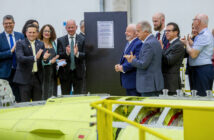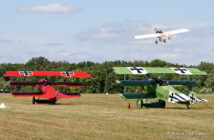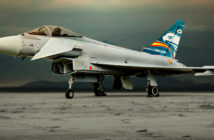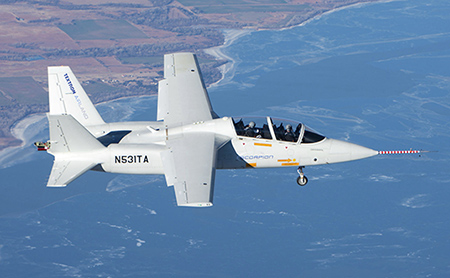
The Textron AirLand Scorpion is the newest combat aircraft to be put through its pace. Developed in cooperation with Cessna in Wichita, Kansas, the twin jet Scorpion expects to fill the ‘low-cost’ segment. The aircraft is powered by a pair of 5,000 lb Honeywell TFE731 turbofans. ©Textron AirLand
The US company Textron AirLand successfully completed the first flight of its Scorpion combat jet, a new ‘low-cost’ tactical twinjet, which was announced earlier this year after it had been developed under full secrecy. The Scorpion took off from McConnell Air Force Base and flew for 1.4 hours.
“The flight was completed according to plan,” said test pilot Dan Hinson. “Having flown many tactical aircraft throughout my 23-year career with the U.S. Navy and with other aircraft manufacturers, I can say that the Scorpion compares very favorably to more costly aircraft currently used for low-threat missions.”
The goal for the first flight was to “evaluate low speed handling characteristics especially in the landing configuration to make sure that we have good controllability,” said the Scorpion programme’s lead engineer Dale Tutt. “As we proceed into the following flight test plans it will really be about expanding out to higher altitudes, higher speeds and evaluating the airplane in different configurations.”
The team had already evaluated the current configuration of the airplane through low-speed wind tunnel testing in September 2012 in San Diego and high-speed wind tunnel testing in January of this year at a facility in the UK. According to Textron AirLand’s president Bill Anderson, the Scorpion design was first conceived on 9 January 2012. Getting a military jet from the drawing board to the skies in less than two years is ambitious, to say the least. But the team employed some clever strategies to get there. One of the reasons the development went so quickly is that the Scorpion incorporates a lot of existing or mature systems, some directly off the Cessna Citation product lines. The commercial turbofan engines also keep fuel burns much lower than that of conventional military aircraft. Indeed, the Scorpion was designed with a business jet approach, and it can compare a lot of the economics of current business jets.
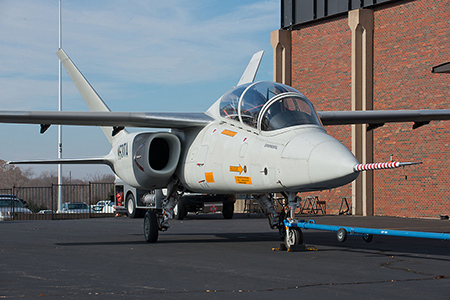
Interestingly enough, the new Scorpion uses many sub-components (including engines) from the Cessna line of business jets in order to keep its price and operating costs as low as possible. This aircraft could well become the true successor of the legacy Northrop F-5 Freedom Fighter. ©Textron AirLand
The Scorpion is powered by two dependable Honeywell TFE731 turbofan engines which together produce approximately 8,000 pounds of useable thrust. The engines are directed by a FADEC system and supply conditioned bleed air to the pneumatic system, as well as to accessories mounted on the engine gearbox power electrical and hydraulic systems. The engines can operate on Jet-A, JP-5, and JP-8 jet fuels.
The design team also brought in suppliers early and, in some cases, designed the airplane around many existing systems, including the Martin Baker ejection seats. The development strategies have enabled Textron AirLand to keep the cost of the Scorpion below $20 million, something which should certainly make the aircraft attractive to many smaller air arms. The cost of operations is expected to be below $3,000 per hour, a significant decrease in cost over other military jets. According to retired USAF Major General Paul Weaver Jr., the Air Force has quoted the cost per hour for the A-10 Thunderbolt II at about $13,000 against €15,000 for the 16 Fighting Falcon, while the F-15 Eagle reaches as much as $23,000.
The idea of the Scorpion came from visionaries at AirLand rightly appalled by the price of the new generation combat jets,and the project was entirely funded by Textron. There are, however, not yet any customers for the Scorpion. “We don’t have any contracts but we certainly have a lot of positive interest both domestically and from the international market,” Anderson said. “We could be delivering our first conforming airplane to a customer in 15 to 18 months after a contract has been signed. We have the facilities and the tools to build another airplane immediately.”

